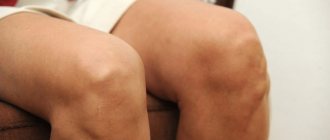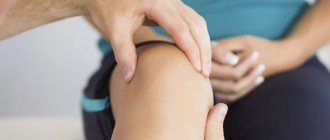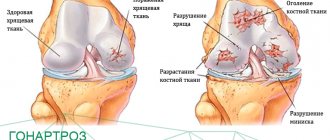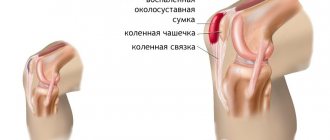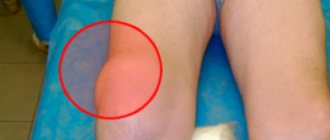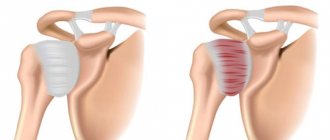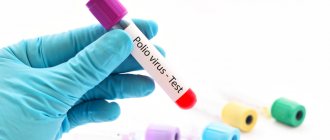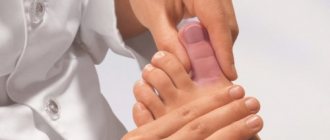Synovitis is a common cause of joint pain not only among athletes and those involved in physical labor.
Inflammation of the synovial membrane can occur in anyone, even in response to any other disease. Most often the disease affects the knee and elbow joints. Without proper treatment, synovitis tends to become chronic, and quality of life can be seriously affected. Synovitis of the knee joint is a rather serious disease that can develop as a result of a huge number of reasons. There is a whole arsenal of medication and complementary therapy for its treatment, however, the disease is very difficult to treat.
Description
Synovitis of the knee joint and other joints is a disease based on dysfunction of the synovial membrane as a result of inflammation. The inner surface of the joint capsule is covered with connective tissue, the surface of which has villi. The membrane cells synthesize synovium (synovial fluid), which improves the gliding of articular surfaces during movement and delivers oxygen and nutrients to the articular tissues.
For normal functioning, the joint contains 2-3 ml of joint secretion. As synovitis develops, the knee becomes completely filled with fluid. This is due not only to increased production, but also to the loss of the ability to reabsorb excess effusion. In this case, the composition and consistency of the synovium changes. It becomes viscous and can acquire a different composition, the nature of which depends on the cause of the disease.
Features of chronic and acute forms
Chronic synovitis is rare. In most cases, it appears if no therapeutic measures were taken during the acute form of the disease or if there is an allergy. With a sluggish course of synovitis, the symptoms are less pronounced. The person is bothered by slight pain and swelling, but there is no redness or temperature.
The acute form of the disease is characterized by severe pain and swelling. In acute cases, synovitis is almost always considered primary. Often acute inflammation of the synovial membrane occurs due to infection.
Pathogenesis
Synovitis of the knee joint is most often a secondary pathology, which is a complication of damage to articular cells. The mechanism of development of the disease is the damage to synovial cells by active inflammatory enzymes, which are secreted by the lysosomes of dead cells. As a result, metabolic reactions change over the necrotic area. The synthesis of large amounts of fluid can be attributed to the body's compensatory response to the inflammatory response.
Depending on the etiological factor, the exudate has a different composition. This may be a serous translucent fluid or purulent effusion. The latter is a product of the vital activity of microorganisms. The pathogenic secretion may also contain fibrinogen, which as a result of a biochemical reaction is converted into fibrin strands. Gradually, foreign components grow into connective tissue and form scars, which over time leads to contracture (restriction of joint mobility).
Prognosis for recovery
With timely treatment, acute aseptic synovitis (that is, without infection entering the cavity) can be successfully treated with conservative methods in 75% of cases. Therapy lasts from 2 to 4 weeks.
Chronic pathologies are less amenable to conservative treatment. In 65% of cases, the knee must be operated on to remove parts of the thickened synovium of the joint that limit the movement of the knee. Postoperative treatment lasts from 3 to 4 weeks.
Infectious synovitis in 100% of cases is treated surgically (by opening the cavity and clearing it of pus). It is very dangerous due to its rapid development; if not treated in a timely manner, it can cause purulent arthritis, and in extreme cases, sepsis. The amount of toxic inflammatory products increases so much that they poison the body and a systemic inflammatory reaction occurs, which usually ends in death.
It takes 2 to 3 months to fully restore the functions of the knee joint after any treatment.
Classification
In orthopedic practice, there are several types of synovitis of the knee joint, differing in causes, duration, and morphological characteristics.
Considering the period of time during which the disease accompanies the patient:
- Acute – up to 21 days;
- chronic – more than 1 month.
According to the composition of the fluid that accumulates in the joint:
- Serous - with a transparent exudate, which subsequently acquires a yellowish tint. Appears without the influence of an infectious factor.
- Fibrinous - a dense secretion with a large amount of fibrinogen. Most often appears with viral and fungal infections.
- Purulent - green exudate with a foul odor, signals the penetration of pyogenic bacteria into the joint cavity.
- Mixed – combined forms occur: serous-fibrinous, purulent-fibrinous.
- Hemorrhagic - with a large number of red blood cells, which color the synovium pink.
According to the etiological origin, there is the following division:
- Aseptic - without the presence of pathogenic bacteria.
- Infectious – caused by microbes.
- Post-traumatic – develops as a result of joint injury.
- Autoimmune – when immune aggression occurs and is directed against one’s own cells.
- Metabolic – when metabolic reactions are disrupted.
In addition, the disease can be primary, the cause of which cannot be determined. This type is called idiopathic. Another type is a consequence of damage to articular tissues or a pathological process - secondary synovitis of the knee joint.
How to treat synovitis of the knee joint?
Content:
Synovitis of joints is inflammation of the synovial (inner) membrane that covers the joint cavity. During the inflammatory process, effusion is formed, fluid accumulates in the joint capsule. When infection penetrates, the effusion turns into purulent contents - at this point purulent synovitis develops. More often, inflammation affects the knee joint, since it experiences significant stress.
Based on the reasons that caused the disease, infectious or non-infectious synovitis is distinguished, based on the nature of its course - chronic or acute.
Causes
Synovitis of the knee joint in children and adults can be of various origins. The development of an inflammatory reaction in the joint is facilitated by various types of knee injuries:
- Bruised injury;
- dislocation;
- sprained or torn ligaments;
- meniscus damage;
- crack or fracture.
In addition to mechanical damage due to external force or as a result of a fall, the cause of synovitis of the knee joint, according to reviews, is often micro-tears of fibers after heavy physical activity or frequently repeated movements with tension.
Pathological prerequisites include:
- Arthrosis is a destructive disease of cartilage and bone tissue;
- arthritis - inflammation in a joint;
- Baker's cyst is a hernial protrusion filled with inflammatory synovial fluid;
- oncological neoplasms;
- bursitis is an inflammatory reaction in the cavity of the synovial bursa (bursa), located on the side of the joint, on its front part or under the patella;
- rheumatoid arthritis - appears due to autoimmune disorders;
- viral diseases;
- specific infections – tuberculosis, brucellosis, gonorrhea;
- fungal infections.
In addition to direct causes, there are predisposing factors that can provoke synovitis of the left or right knee joint:
- Increased body weight;
- endocrine disorders;
- hormonal disbalance;
- unbalanced diet;
- metabolic disease;
- sedentary lifestyle;
- prolonged physical inactivity;
- bad habits - smoking or drinking alcohol.
Frequent visits to the doctor with suspected synovitis of the right or left knee joint have been recorded in older people. This is due to degenerative-dystrophic changes that occur as a result of natural involutive processes.
Exercise therapy
Exercise therapy for synovitis should be very gentle so that movements do not create increased pressure in the diseased joint, which will further increase tissue ischemia.
You need to do the exercises lying on your back, starting from 5 minutes a day - from the seventh day of illness:
- First, you simply raise your straightened leg 15 cm from the floor, holding it in this position for several minutes.
- Very carefully bend and straighten your foot from exactly the same starting position.
- Raise and lower the straight leg with low intensity, starting from 5 times, bringing the number of swings to 15 by the 10th session.
You cannot squat, straighten or bend your leg at the knee, swing it very actively, or perform movements that will cause pain in the joint.
Symptoms
When synovitis of the knee joint appears, the symptoms vary in severity and variety. Any form of the disease is accompanied by signs characteristic of inflammation. The clinical picture of each type has a number of distinctive symptoms.
Synovitis of the knee joint in children and adults is accompanied by the following manifestations:
- A pain symptom occurs in response to irritation of receptors and the pressure of a large amount of fluid on surrounding tissues. In serous forms, the pain syndrome is of a moderate aching nature, purulent synovitis leads to severe throbbing pain.
- Edema is the result of the accumulation of excess fluid in the soft periarticular tissues. In mild forms of inflammation, the knee swells slightly; in severe cases, severe swelling develops.
- A local increase in body temperature over the joint is a characteristic symptom of inflammation. The hotter the joint is to the touch, the more actively the pathological reaction develops.
- Hyperemia indicates internal disorders in the joint. The skin may change color and become pale pink, and in some cases, dark purple.
- Deformation of the knee joint manifests itself in an increase in the articulation and its acquisition of a ball shape. This phenomenon is explained by the filling of the cavity of the joint capsule with liquid, which creates pressure on the walls of the capsule and stretches them, smoothing the edges.
The general condition, as a rule, does not change. An increase in body temperature to subfebrile levels may accompany fibrinous synovitis. When a secondary infection occurs or pyogenic bacteria enter the cavity of the bursa, the clinical picture of the disease changes:
- The pain intensifies and becomes pulsating;
- the knee becomes very swollen and hot;
- mild hyperemia gives way to severe redness;
- symptoms of general intoxication are observed - fever, headache, weakness;
- movements in the knee joint are severely limited, extension of the joint is almost impossible.
Disease prognosis
For acute aseptic and allergic synovitis, the prognosis is positive. After adequate treatment, the inflammation is completely eliminated, the effusion disappears, and movement is preserved. With a purulent course of the disease, contractures can sometimes appear.
In severe cases, the development of life-threatening complications cannot be ruled out. With this diagnosis, the prognosis is negative. Chronic aseptic synovitis can lead to stiffness. After surgery, relapse may occur. Sometimes contracture develops.
Want to get the same treatment, ask us how?
Possible complications
If adequate treatment for synovitis of the knee joint is not carried out or unsuccessful attempts at self-therapy are made, secondary conditions develop that can cause significant damage to health:
- Deforming arthrosis (gonarthrosis) – secondary degeneration of the cartilage and bone tissue of the joint;
- sepsis is a general blood infection that develops when microorganisms enter the vascular bed;
- contracture – restriction of joint mobility due to shortening of the knee ligaments;
- ankylosis – immobility of the knee joint.
In addition, some patients experience shortening of the limb, due to which the gait changes and lameness appears. Therefore, in order to prevent irreversible phenomena, it is necessary to properly treat synovitis of the knee joint.
Prevention
The following measures will help reduce the risk of joint damage:
- Every injury and bruise must be treated by a specialist, avoiding complications.
- If you have chronic and infectious diseases, you should listen to your body and consult a doctor at the first warning signs.
- Try to wear comfortable shoes, and when exercising, use knee pads to support your joints.
Preventing the disease is not difficult; it is important to follow certain rules and consult a specialist in a timely manner.
Osteoarthritis of the knee joint Osteoarthritis of the knee joint Arthritis of the knee joint Bursitis of the knee joint Arthritis of the shoulder joint Coxarthrosis
Diagnostics
The diagnosis of “synovitis of the knee joint” is made by an orthopedist or surgeon with the participation of specialists of a narrow specialization if concomitant pathologies are suspected. What it is is clarified by clinical symptoms, examination results and hardware diagnostics. During the interview, the doctor finds out the nature and duration of symptoms, possible injuries, type of activity and lifestyle.
During a physical examination, the etiology of the disease is assumed, tests are performed to determine the preserved range of motion and the presence of fluid in the joint capsule. In addition to significant enlargement of the knee, fluctuation (accumulation of effusion) is determined by pressing with the fingers of one hand on opposite sides of the enlarged joint. If a “push” is felt, then the fluctuation is positive.
What is synovitis and how to treat it is determined after objective research methods:
- X-ray – prescribed to determine bone changes;
- magnetic resonance imaging - to assess the condition of soft tissues;
- arthroscopy – is carried out to examine the inner surface of the joint using a medical device with a microscopic camera, the image from which is displayed on the monitor;
- diagnostic puncture – to collect joint exudate for bacteriological examination to determine the type of pathogen.
Based on the results obtained, an accurate diagnosis and its etiological origin are determined in order to correctly select therapeutic tactics and cure synovitis of the knee joint.
Treatment
To prevent relapses, the disease of inflammatory origin requires complex treatment. In order to cure synovitis of the knee joint, drug therapy, rest and physiotherapy are prescribed. It is possible to achieve complete elimination of the pathological process with the help of therapeutic puncture, which is carried out among the first therapeutic procedures.
Puncture
Puncture of the joint for the purpose of pumping out exudate is prescribed as the most effective method of treating synovitis of the knee joint. The minimally invasive procedure takes place under local anesthesia. Moreover, puncture in this case also serves as a diagnostic procedure. A special needle, through which exudate is evacuated, is inserted into the joint cavity. A sterile syringe is connected to the needle, and the first portion is sent for laboratory examination.
Next, all the liquid is pumped out, and the cavity is washed with an antiseptic solution. After this, antibiotics are used for synovitis of the knee joint, which are injected into the joint capsule. Most often, a positive effect occurs after the first procedure. If the joint refills with effusion, the manipulation is repeated again.
Medicines
When prescribing pharmacological drugs, symptoms are taken into account, and treatment is designed to alleviate the patient’s condition:
- Non-steroidal anti-inflammatory drugs , as an analgesic and anti-inflammatory agent - Indomethacin, Diclofenac;
- antibiotics for synovitis of the knee joint to destroy the pathogen - Erythromycin, Ampicillin;
- diuretics for severe edema - Furosemide, Diuver;
- in the absence of an analgesic effect from NSAIDs , glucocorticosteroids are prescribed - Dexamethasone, Prednisolone ;
- chondroprotectors to stop reactions that destroy the joint - Dona, Structum .
Physiotherapy
When the acute period of synovitis of the knee joint passes, restorative treatment is carried out, which, according to reviews, promotes a speedy recovery.
The following methods are effective for synovitis:
- Magnetotherapy;
- electrophoresis;
- UHF;
- laser therapy;
- ultrasonic influence.
Each method is carried out in courses, during which blood microcirculation, tissue nutrition, and regeneration of damaged areas improve.
Orthopedic mode
In the first days of the onset of the disease, it is recommended to observe bed rest, how to treat is determined according to the symptoms, and treatment is carried out by limiting the load on the diseased joint. If independent movement is necessary, a rigid fixation orthosis is put on the affected joint. The knee pad securely holds the joint and relieves stress during movement. If a person is lying down, he does not need a knee brace.
In addition to an orthopedic device, crutches or a walker are used for movement. Loads for synovitis of the knee joint should be absent during the treatment period; with thoughtless physical activity, the therapeutic actions taken can be reduced to zero, which is confirmed by reviews.
Operation
If synovitis becomes chronic, and the pain cannot be relieved conservatively, surgical treatment is performed:
- Arthroscopy – cleansing and treatment using a minimally invasive procedure under the visual guidance of a micro-camera. Through 3 small punctures, the arthroscope and surgical instruments are inserted. During the operation, exudate is evacuated, and parts of the joint capsule are removed.
- Synovectomy - resection of the damaged area of the synovial membrane is performed, after which antibiotics are prescribed for synovitis of the knee joint, both for systemic exposure and for intra-articular procedures.
Physiotherapy
From approximately the third day of development of the disease, the patient is prescribed a course of physiotherapy.
Using this method of influence it is possible to achieve the following goals:
- Eliminate pain.
- Restore joint mobility.
- Strengthen lymphatic drainage of tissues.
- Improve blood circulation to the inflamed area.
This may involve:
- Magnetotherapy is the effect of low-frequency pulses on the affected area. Prescribed only to elderly patients with chronic synovitis. With the help of the procedure, it is possible to improve joint mobility, relieve pain, and promote the restoration of damaged tissue and cartilage
- SMT (sinusoidally modulated current therapy). SMT is a therapy that is prescribed for acute pain, at the very beginning of the development of the disease. When exposed to SM currents, a loss of sensitivity of pain receptors occurs. there is a rush of blood, the articular cartilage begins to recover. Heat treatment is carried out only at the first stage of the disease.
- Electrophoresis is the most effective treatment method, which uses electrical impulses to deliver medicine directly to the joint. By quickly delivering the medication to the inflamed area, it is possible to achieve maximum results: swelling goes away, the joint becomes more mobile, pain is eliminated, and recovery is much faster.
